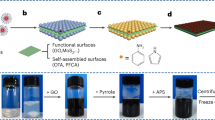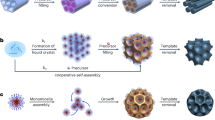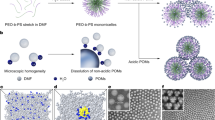Abstract
High-surface-area mesoporous materials expose abundant functional sites for improved performance in applications such as gas storage/separation, catalysis, and sensing. Recently, soft templates composed of amphiphilic surfactants and block copolymers have been used to introduce mesoporosity in various materials, including metals, metal oxides and carbonaceous compounds. In particular, mesoporous metals are attractive in electrocatalysis because their porous networks expose numerous unsaturated atoms on high-index facets that are highly active in catalysis. In this protocol, we describe how to create mesoporous metal films composed of gold, palladium, or platinum using block copolymer micelle templates. The amphiphilic block copolymer micelles are the sacrificial templates and generate uniform structures with tunable pore sizes in electrodeposited metal films. The procedure describes the electrodeposition in detail, including parameters such as micelle diameters, deposition potentials, and deposition times to ensure reproducibility. The micelle diameters can be controlled by swelling the micelles with different solvent mixtures or by using block copolymer micelles with different molecular weights. The deposition potentials and deposition times allow further control of the mesoporous structure and its thickness, respectively. Procedures for example applications are included: glucose oxidation, ethanol oxidation and methanol oxidation reactions. The synthetic methods for preparation of mesoporous metal films will take ~4 h; the subsequent electrochemical tests will take ~5 h for glucose sensing and ~3 h for alcohol oxidation reaction.
This is a preview of subscription content, access via your institution
Access options
Access Nature and 54 other Nature Portfolio journals
Get Nature+, our best-value online-access subscription
$29.99 / 30 days
cancel any time
Subscribe to this journal
Receive 12 print issues and online access
$259.00 per year
only $21.58 per issue
Buy this article
- Purchase on Springer Link
- Instant access to full article PDF
Prices may be subject to local taxes which are calculated during checkout












Similar content being viewed by others
References
Shin, H. J., Ryoo, R., Liu, Z. & Terasaki, O. Template synthesis of asymmetrically mesostructured platinum networks. J. Am. Chem. Soc. 123, 1246–1247 (2001).
Liu, Z. et al. TEM studies of platinum nanowires fabricated in mesoporous silica MCM-41. Angew. Chem. Int. Ed. 39, 3107–3110 (2000).
Takai, A., Doi, Y., Yamauchi, Y. & Kuroda, K. Soft-chemical approach of noble metal nanowires templated from mesoporous silica (SBA-15) through vapor infiltration of a reducing agent. J. Phys. Chem. C. 114, 7586–7593 (2010).
Doi, Y. et al. Tailored synthesis of mesoporous platinum replicas using double gyroid mesoporous silica (KIT-6) with different pore diameters via vapor infiltration of a reducing agent. Chem. Commun. 46, 6365–6367 (2010).
Guo, X.-J., Yang, C.-M., Liu, P.-H., Cheng, M.-H. & Chao, K.-J. Formation and growth of platinum nanostructures in cubic mesoporous silica. Cryst. Growth Des. 5, 33–36 (2005).
Kuroda, Y., Yamauchi, Y. & Kuroda, K. Integrated structural control of cage-type mesoporous platinum possessing both tunable large mesopores and variable surface structures by block copolymer-assisted Pt deposition in a hard-template. Chem. Commun. 46, 1827–1829 (2010).
Attard, G. S. et al. Mesoporous platinum films from lyotropic liquid crystalline phases. Science 278, 838–840 (1997).
Attard, G. S., Corker, J. M., Göltner, C. G., Henke, S. & Templer, R. H. Liquid-crystal templates for nanostructured metals. Angew. Chem. Int. Ed. 36, 1315–1317 (1997).
Elliott, J. M., Birkin, P. R., Bartlett, P. N. & Attard, G. S. Platinum microelectrodes with unique high surface areas. Langmuir 15, 7411–7415 (1999).
Bartlett, P. N., Pletcher, D., Esterle, T. F. & John Low, C. T. The deposition of mesoporous Ni/Co alloy using cetyltrimethylammonium bromide as the surfactant in the lyotropic liquid crystalline phase bath. J. Electroanal. Chem. 688, 232–236 (2013).
Thepkaew, J., Therdthianwong, S., Kucernak, A. & Therdthianwong, A. Electrocatalytic activity of mesoporous binary/ternary PtSn-based catalysts for ethanol oxidation. J. Electroanal. Chem. 685, 41–46 (2012).
Li, C. et al. Electrochemical synthesis of mesoporous gold films toward mesospace-stimulated optical properties. Nat. Commun. 6, 6608 (2015).
Jiang, B. et al. Tunable‐sized polymeric micelles and their assembly for the preparation of large mesoporous platinum nanoparticles. Angew. Chem. Int. Ed. 55, 10037–10041 (2016).
Kang, Y. et al. Mesoporous PtCu alloy nanoparticles with tunable compositions and particles sizes using diblock copolymer micelle templates. Chem. Eur. J. 25, 343–348 (2019).
Jiang, B. et al. Mesoporous metallic rhodium nanoparticles. Nat. Commun. 8, 15581 (2017).
Iqbal, M. et al. Continuous mesoporous Pd films by electrochemical deposition in nonionic micellar solution. Chem. Mater. 29, 6405–6413 (2017).
Li, C. et al. First synthesis of continuous mesoporous copper films with uniformly sized pores by electrochemical soft templating. Angew. Chem. 128, 12938–12942 (2016).
Iqbal, M. et al. Standing mesochannels: mesoporous PdCu films with vertically aligned mesochannels from nonionic micellar solutions. ACS Appl. Mater. Interfaces 10, 40623–40630 (2018).
Tang, J., Liu, J., Torad, N. L., Kimura, T. & Yamauchi, Y. Tailored design of functional nanoporous carbon materials toward fuel cell applications. Nano Today 9, 305–323 (2014).
Jiang, B. et al. Layer-by-layer motif architectures: programmed electrochemical syntheses of multilayer mesoporous metallic films with uniformly sized pores. Angew. Chem. 129, 7944–7949 (2017).
Sun, Y. et al. Defects and interfaces on PtPb nanoplates boost fuel cell electrocatalysis. Small 14, 1702259 (2018).
Li, Y. et al. Polymeric micelle assembly for the smart synthesis of mesoporous platinum nanospheres with tunable pore sizes. Angew. Chem. Int. Ed. 54, 11073–11077 (2015).
Jiang, B. et al. Mesoporous Pt nanospheres with designed pore surface as highly active electrocatalyst. Chem. Sci. 7, 1575–1581 (2016).
Jiang, B., Li, C., Imura, M., Tang, J. & Yamauchi, Y. Multimetallic mesoporous spheres through surfactant‐directed synthesis. Adv. Sci. 2, 1500112 (2015).
Wang, L. & Yamauchi, Y. Metallic nanocages: synthesis of bimetallic Pt–Pd hollow nanoparticles with dendritic shells by selective chemical etching. J. Am. Chem. Soc. 135, 16762–16765 (2013).
Eid, K. et al. One-step synthesis of porous bimetallic PtCu nanocrystals with high electrocatalytic activity for methanol oxidation reaction. Nanoscale 7, 16860–16866 (2015).
Jiang, B., Li, C., Malgras, V. & Yamauchi, Y. Synthesis of ternary PtPdCu spheres with three-dimensional nanoporous architectures toward superior electrocatalysts. J. Mater. Chem. A 3, 18053–18058 (2015).
Deng, K. et al. PtPdRh mesoporous nanospheres: an efficient catalyst for methanol electro-oxidation. Langmuir 35, 413–419 (2018).
Li, C. et al. Pore-tuning to boost the electrocatalytic activity of polymeric micelle-templated mesoporous Pd nanoparticles. Chem. Sci. 10, 4054–4061 (2019).
Lv, H. et al. Size-dependent synthesis and catalytic activities of trimetallic PdAgCu mesoporous nanospheres in ethanol electrooxidation. Chem. Sci. 10, 1986–1993 (2019).
Lv, H., Lopes, A., Xu, D. & Liu, B. Multimetallic hollow mesoporous nanospheres with synergistically structural and compositional effects for highly efficient ethanol electrooxidation. ACS Cent. Sci. 4, 1412–1419 (2018).
Li, C. et al. Superior electrocatalytic activity of mesoporous Au film templated from diblock copolymer micelles. Nano Res. 9, 1752–1762 (2016).
Kani, K. et al. Electrochemical supermolecular templating of mesoporous Rh films. Nanoscale 11, 10581–10588 (2019).
Li, C. et al. Surfactant-directed synthesis of mesoporous Pd films with perpendicular mesochannels as efficient electrocatalysts. J. Am. Chem. Soc. 137, 11558–11561 (2015).
Iqbal, M. et al. Continuous mesoporous Pd films with tunable pore sizes through polymeric micelle-assisted assembly. Nanoscale Horiz. 4, 960–968 (2019).
Li, C., Wang, H. & Yamauchi, Y. Electrochemical deposition of mesoporous Pt–Au alloy films in aqueous surfactant solutions: towards a highly sensitive amperometric glucose sensor. Chem. Eur. J. 19, 2242–2246 (2013).
Ma, L. et al. Mesoporous bimetallic PtPd nanoflowers as a platform to enhance electrocatalytic activity of acetylcholinesterase for organophosphate pesticide detection. Electroanalysis 30, 1801–1810 (2018).
Chang, F.-C., Li, Y.-C., Wu, R.-J. & Chen, C.-H. Pt–Pd floating nanoarrays templated on pluronic F127 micelles as effective surface-enhanced Raman scattering sensors. ACS Appl. Nano Mater. 2, 2515–2524 (2019).
Libera, M. R. & Egerton, R. F. Advances in the transmission electron microscopy of polymers. Polym. Rev. 50, 321–339 (2010).
Patterson, J. P. et al. The analysis of solution self-assembled polymeric nanomaterials. Chem. Soc. Rev. 43, 2412–2425 (2014).
Balcerzak, M. Sample digestion methods for the determination of traces of precious metals by spectrometric techniques. Anal. Sci. 18, 737–750 (2002).
Nugraha, A. S. et al. Block-copolymer-assisted electrochemical synthesis of mesoporous gold electrodes: towards a non-enzymatic glucose sensor. ChemElectroChem 4, 2571–2576 (2017).
Liang, Z., Zhao, T., Xu, J. & Zhu, L. Mechanism study of the ethanol oxidation reaction on palladium in alkaline media. Electrochim. Acta 54, 2203–2208 (2009).
Acknowledgements
H.L. and K.K. are funded by The University of Queensland Research and Training Program. This work was performed in part at the Queensland node of the Australian National Fabrication Facility (ANFF-Q), a company established under the National Collaborative Research Infrastructure Strategy to provide nano- and micro-fabrication facilities for Australia’s researchers. The authors acknowledge the facilities, and the scientific and technical assistance, of the Australian Microscopy & Microanalysis Research Facility at the Centre for Microscopy and Microanalysis, The University of Queensland. This work is also supported by the Korea Institute of Industrial Technology (KITECH, JE200017).
Author information
Authors and Affiliations
Contributions
Y.Y. and J.N. proposed the research direction and guided the project. Y.Y., J.N., and Y.B. developed the protocol. H.L. and K.K. performed the experiments. H.L., K.K., and J.H. drafted the manuscript. J.H., T.N., A.S.N., Y.S.O., and K.C.W.W. analyzed morphologies. M.I., M.S.A.H., A.E.R., and H.-J.K. did formal analysis. All authors contributed to the manuscript.
Corresponding authors
Ethics declarations
Competing interests
The authors declare no competing interests.
Additional information
Peer review information Nature Protocols thanks Xiaoguo Liu, Liang Wang and Dongyuan Zhao for their contribution to the peer review of this work.
Publisher’s note Springer Nature remains neutral with regard to jurisdictional claims in published maps and institutional affiliations.
Related links
Key references using this protocol
Li, C. et. al. Nat. Commun. 6, 6608 (2015): https://www.nature.com/articles/ncomms7608
Iqbal, M. et. al. Nanoscale Horiz. 4, 960–968 (2019): https://pubs.rsc.org/en/content/articlelanding/2019/nh/c8nh00507a#!divAbstract
Nugraha, A. S., et. al. ChemElectroChem 4, 2571–2576 (2017): https://doi.org/10.1002/celc.2017005
Key data used in this protocol
Li, C. et. al. Nat. Commun. 6, 6608 (2015): https://www.nature.com/articles/ncomms7608
Supplementary information
Supplementary Information
Supplementary Table 1 and Supplementary Figs. 1 and 2.
Rights and permissions
About this article
Cite this article
Lim, H., Kani, K., Henzie, J. et al. A universal approach for the synthesis of mesoporous gold, palladium and platinum films for applications in electrocatalysis. Nat Protoc 15, 2980–3008 (2020). https://doi.org/10.1038/s41596-020-0359-8
Received:
Accepted:
Published:
Issue Date:
DOI: https://doi.org/10.1038/s41596-020-0359-8
This article is cited by
-
Solvent-pair surfactants enabled assembly of clusters and copolymers towards programmed mesoporous metal oxides
Nature Communications (2023)
-
In situ electrochemical Raman spectroscopy and ab initio molecular dynamics study of interfacial water on a single-crystal surface
Nature Protocols (2023)
-
Simultaneous fabrication of porous metals and metallic nanowires via atmospheric pressure plasma-assisted electro-dealloying
Science China Technological Sciences (2023)
-
MOF-derived nanoporous carbons with diverse tunable nanoarchitectures
Nature Protocols (2022)
-
Degradable mesoporous semimetal antimony nanospheres for near-infrared II multimodal theranostics
Nature Communications (2022)
Comments
By submitting a comment you agree to abide by our Terms and Community Guidelines. If you find something abusive or that does not comply with our terms or guidelines please flag it as inappropriate.



